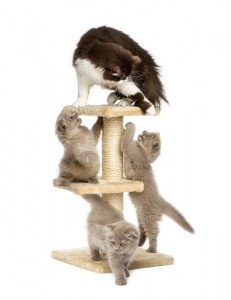The Truth About Declawing
Declawing your cat can cause serious physical, emotional and behavioural complications.
Painful surgery, painful recovery
Declawing is the amputation of the last joint of your cat’s “toes”. Imagine having your fingers cut off at the last joint. Ouch! Declawed cats often find walking painful. In fact, it can be so painful, your cat may resort to placing more of her weight on her hindquarters, causing her entire body to go off balance and leading to arthritis in hip bones and other joints.
Without her claws, your cat becomes very distressed because her main means of defence are now gone. As a consequence, she may develop undesirable behaviours, such as urinating and spraying on your furniture. She may become hostile to people around her (including you) because she feels threatened with no means of protection. Some cats may associate the pain in their paws with scratching in the litter, and develop an aversion to the litter box.
Countries like England, France, Germany, Italy and the Netherlands have either completely banned the practice of declawing, or consider the act to be extremely inhumane.

Humane alternatives
If you’re trying to stop your cat from scratching altogether, your efforts are in vain. Scratching is a natural behaviour for our feline friends. It’s their way of marking their territory — not only with claw marks, but with the scent glands on their paws. It also helps them stretch their muscles after a long nap.
Get your cat to scratch where you want her to, and keep her away from the places you consider undesirable:
- Provide your cat with a scratching post. Make sure it’s tall enough to fully stretch her body. Make the post appealing by rubbing dry catnip on it and rewarding her with treats when she uses it.
- Regular nail trimming and covering your valuable objects can help your cat in the transition to the scratching post.
- Use SoftPaws, lightweight vinyl caps that are glued onto your cat’s front claws. They’re easy to apply, last for about 6 weeks, and are extremely useful if you’re away from home for long periods of time and can’t keep a constant, watchful eye on your cat.
Remember, your cat’s claws are an integral part of who she is, and your cat will have to live for the rest of her life with the decisions you make.

